Management Accounting Report: Costing and Budgetary Control
VerifiedAdded on 2021/02/21
|18
|5356
|38
Report
AI Summary
This report delves into the realm of management accounting, examining its core principles and practical applications within the context of Brightstar Limited and its client, Galway Plc. The report explores the essential requirements of various management accounting systems, including inventory management, cost accounting, job costing, and price optimization. It then analyzes different types of management accounting reports, such as performance reports, budget reports, and accounts receivable aging reports, highlighting their significance in decision-making and performance evaluation. Furthermore, the report investigates the benefits of these systems, their organizational applications, and the utilization of appropriate accounting techniques to produce financial reporting documents, including income statements using marginal and absorption costing methods. Budgetary control and planning tools are also examined, along with their application in preparing and forecasting budgets. Finally, the report critically evaluates the role of management accounting in addressing financial problems and achieving sustainable success, offering insights into how organizations can leverage these tools to improve operational effectiveness and profitability. The report emphasizes the importance of these systems and reports in enhancing efficiencies, guiding managers, and fostering sustainable financial health.
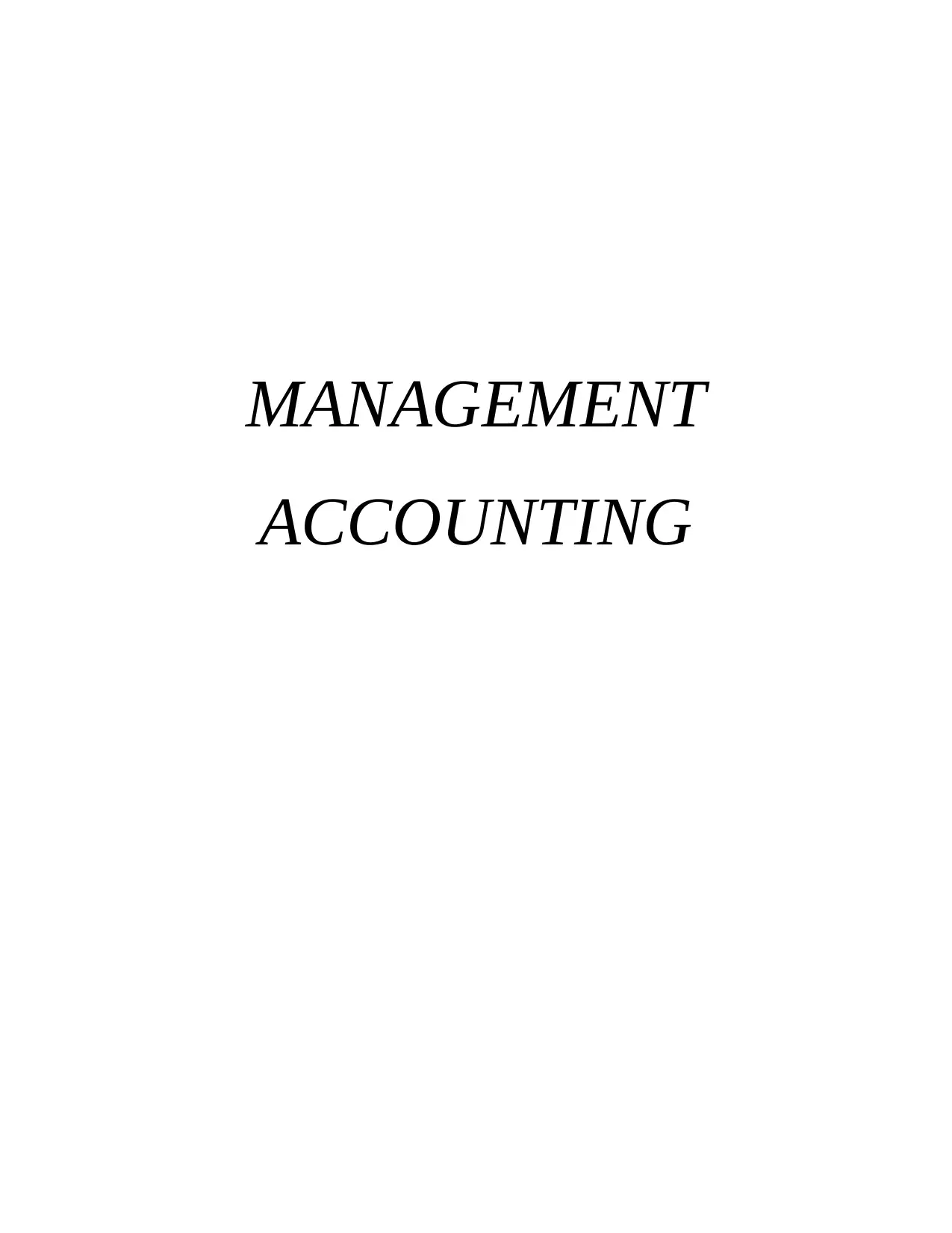
MANAGEMENT
ACCOUNTING
ACCOUNTING
Paraphrase This Document
Need a fresh take? Get an instant paraphrase of this document with our AI Paraphraser
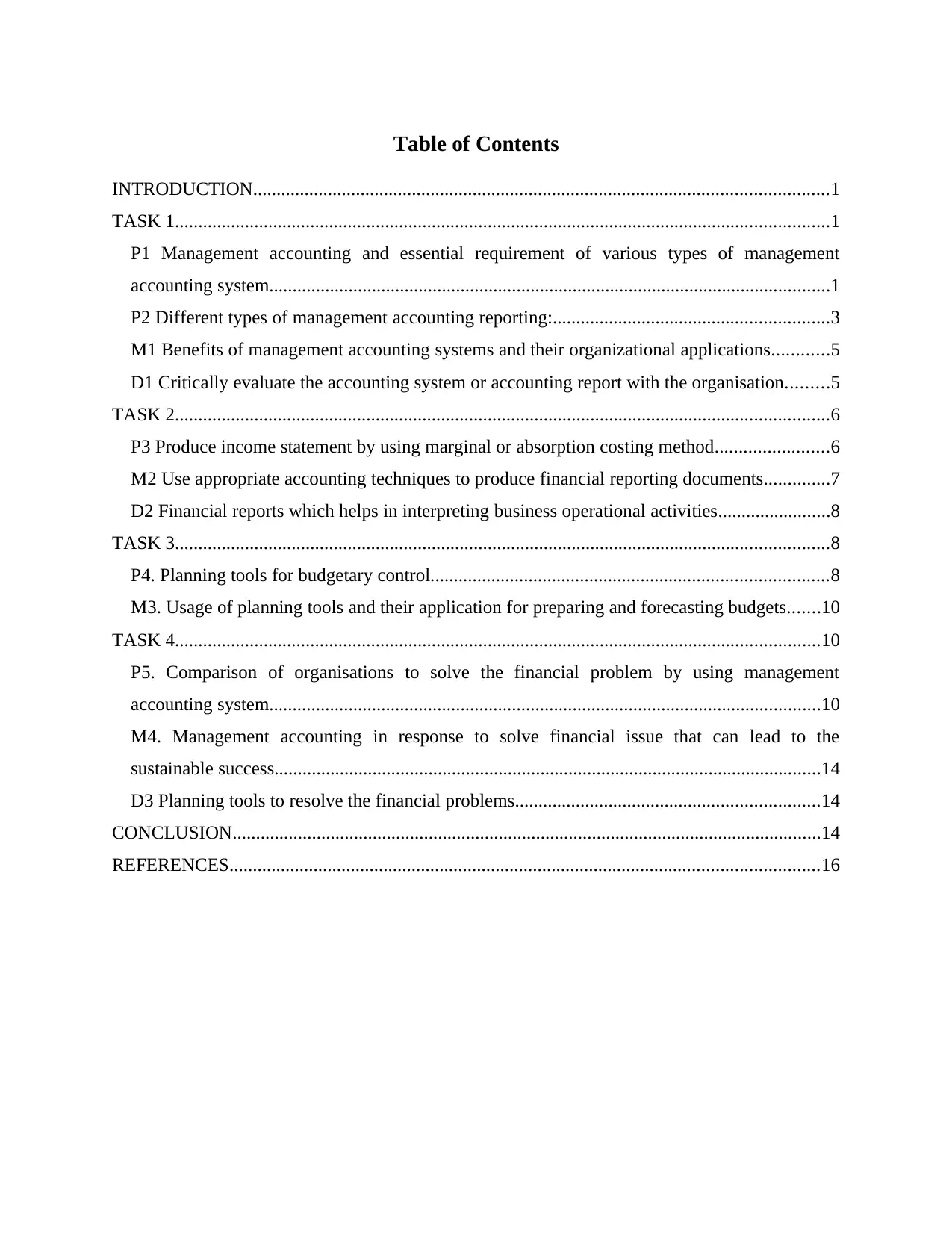
Table of Contents
INTRODUCTION...........................................................................................................................1
TASK 1............................................................................................................................................1
P1 Management accounting and essential requirement of various types of management
accounting system........................................................................................................................1
P2 Different types of management accounting reporting:...........................................................3
M1 Benefits of management accounting systems and their organizational applications............5
D1 Critically evaluate the accounting system or accounting report with the organisation.........5
TASK 2............................................................................................................................................6
P3 Produce income statement by using marginal or absorption costing method........................6
M2 Use appropriate accounting techniques to produce financial reporting documents..............7
D2 Financial reports which helps in interpreting business operational activities........................8
TASK 3............................................................................................................................................8
P4. Planning tools for budgetary control.....................................................................................8
M3. Usage of planning tools and their application for preparing and forecasting budgets.......10
TASK 4..........................................................................................................................................10
P5. Comparison of organisations to solve the financial problem by using management
accounting system......................................................................................................................10
M4. Management accounting in response to solve financial issue that can lead to the
sustainable success.....................................................................................................................14
D3 Planning tools to resolve the financial problems.................................................................14
CONCLUSION..............................................................................................................................14
REFERENCES..............................................................................................................................16
INTRODUCTION...........................................................................................................................1
TASK 1............................................................................................................................................1
P1 Management accounting and essential requirement of various types of management
accounting system........................................................................................................................1
P2 Different types of management accounting reporting:...........................................................3
M1 Benefits of management accounting systems and their organizational applications............5
D1 Critically evaluate the accounting system or accounting report with the organisation.........5
TASK 2............................................................................................................................................6
P3 Produce income statement by using marginal or absorption costing method........................6
M2 Use appropriate accounting techniques to produce financial reporting documents..............7
D2 Financial reports which helps in interpreting business operational activities........................8
TASK 3............................................................................................................................................8
P4. Planning tools for budgetary control.....................................................................................8
M3. Usage of planning tools and their application for preparing and forecasting budgets.......10
TASK 4..........................................................................................................................................10
P5. Comparison of organisations to solve the financial problem by using management
accounting system......................................................................................................................10
M4. Management accounting in response to solve financial issue that can lead to the
sustainable success.....................................................................................................................14
D3 Planning tools to resolve the financial problems.................................................................14
CONCLUSION..............................................................................................................................14
REFERENCES..............................................................................................................................16
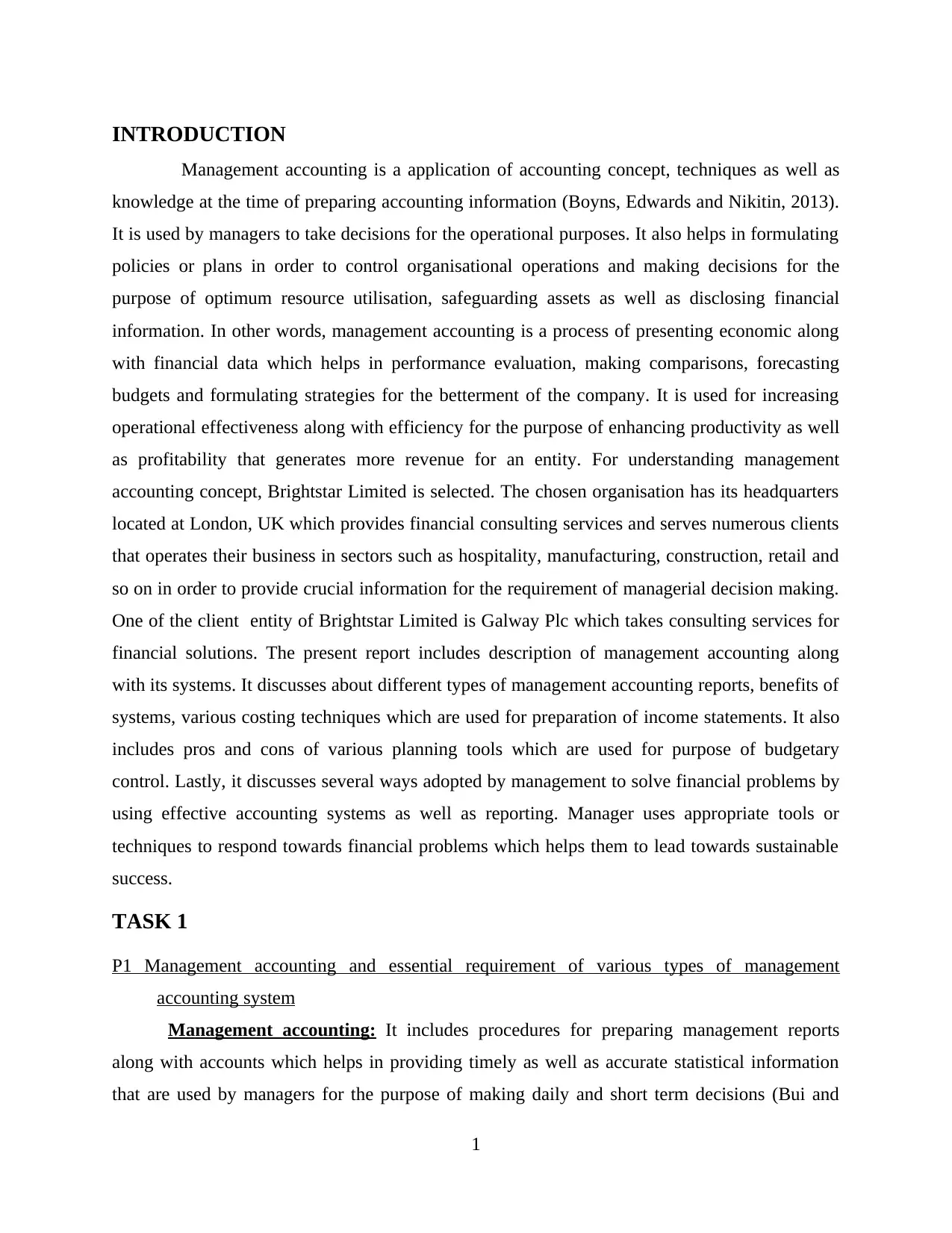
INTRODUCTION
Management accounting is a application of accounting concept, techniques as well as
knowledge at the time of preparing accounting information (Boyns, Edwards and Nikitin, 2013).
It is used by managers to take decisions for the operational purposes. It also helps in formulating
policies or plans in order to control organisational operations and making decisions for the
purpose of optimum resource utilisation, safeguarding assets as well as disclosing financial
information. In other words, management accounting is a process of presenting economic along
with financial data which helps in performance evaluation, making comparisons, forecasting
budgets and formulating strategies for the betterment of the company. It is used for increasing
operational effectiveness along with efficiency for the purpose of enhancing productivity as well
as profitability that generates more revenue for an entity. For understanding management
accounting concept, Brightstar Limited is selected. The chosen organisation has its headquarters
located at London, UK which provides financial consulting services and serves numerous clients
that operates their business in sectors such as hospitality, manufacturing, construction, retail and
so on in order to provide crucial information for the requirement of managerial decision making.
One of the client entity of Brightstar Limited is Galway Plc which takes consulting services for
financial solutions. The present report includes description of management accounting along
with its systems. It discusses about different types of management accounting reports, benefits of
systems, various costing techniques which are used for preparation of income statements. It also
includes pros and cons of various planning tools which are used for purpose of budgetary
control. Lastly, it discusses several ways adopted by management to solve financial problems by
using effective accounting systems as well as reporting. Manager uses appropriate tools or
techniques to respond towards financial problems which helps them to lead towards sustainable
success.
TASK 1
P1 Management accounting and essential requirement of various types of management
accounting system
Management accounting: It includes procedures for preparing management reports
along with accounts which helps in providing timely as well as accurate statistical information
that are used by managers for the purpose of making daily and short term decisions (Bui and
1
Management accounting is a application of accounting concept, techniques as well as
knowledge at the time of preparing accounting information (Boyns, Edwards and Nikitin, 2013).
It is used by managers to take decisions for the operational purposes. It also helps in formulating
policies or plans in order to control organisational operations and making decisions for the
purpose of optimum resource utilisation, safeguarding assets as well as disclosing financial
information. In other words, management accounting is a process of presenting economic along
with financial data which helps in performance evaluation, making comparisons, forecasting
budgets and formulating strategies for the betterment of the company. It is used for increasing
operational effectiveness along with efficiency for the purpose of enhancing productivity as well
as profitability that generates more revenue for an entity. For understanding management
accounting concept, Brightstar Limited is selected. The chosen organisation has its headquarters
located at London, UK which provides financial consulting services and serves numerous clients
that operates their business in sectors such as hospitality, manufacturing, construction, retail and
so on in order to provide crucial information for the requirement of managerial decision making.
One of the client entity of Brightstar Limited is Galway Plc which takes consulting services for
financial solutions. The present report includes description of management accounting along
with its systems. It discusses about different types of management accounting reports, benefits of
systems, various costing techniques which are used for preparation of income statements. It also
includes pros and cons of various planning tools which are used for purpose of budgetary
control. Lastly, it discusses several ways adopted by management to solve financial problems by
using effective accounting systems as well as reporting. Manager uses appropriate tools or
techniques to respond towards financial problems which helps them to lead towards sustainable
success.
TASK 1
P1 Management accounting and essential requirement of various types of management
accounting system
Management accounting: It includes procedures for preparing management reports
along with accounts which helps in providing timely as well as accurate statistical information
that are used by managers for the purpose of making daily and short term decisions (Bui and
1
⊘ This is a preview!⊘
Do you want full access?
Subscribe today to unlock all pages.

Trusted by 1+ million students worldwide
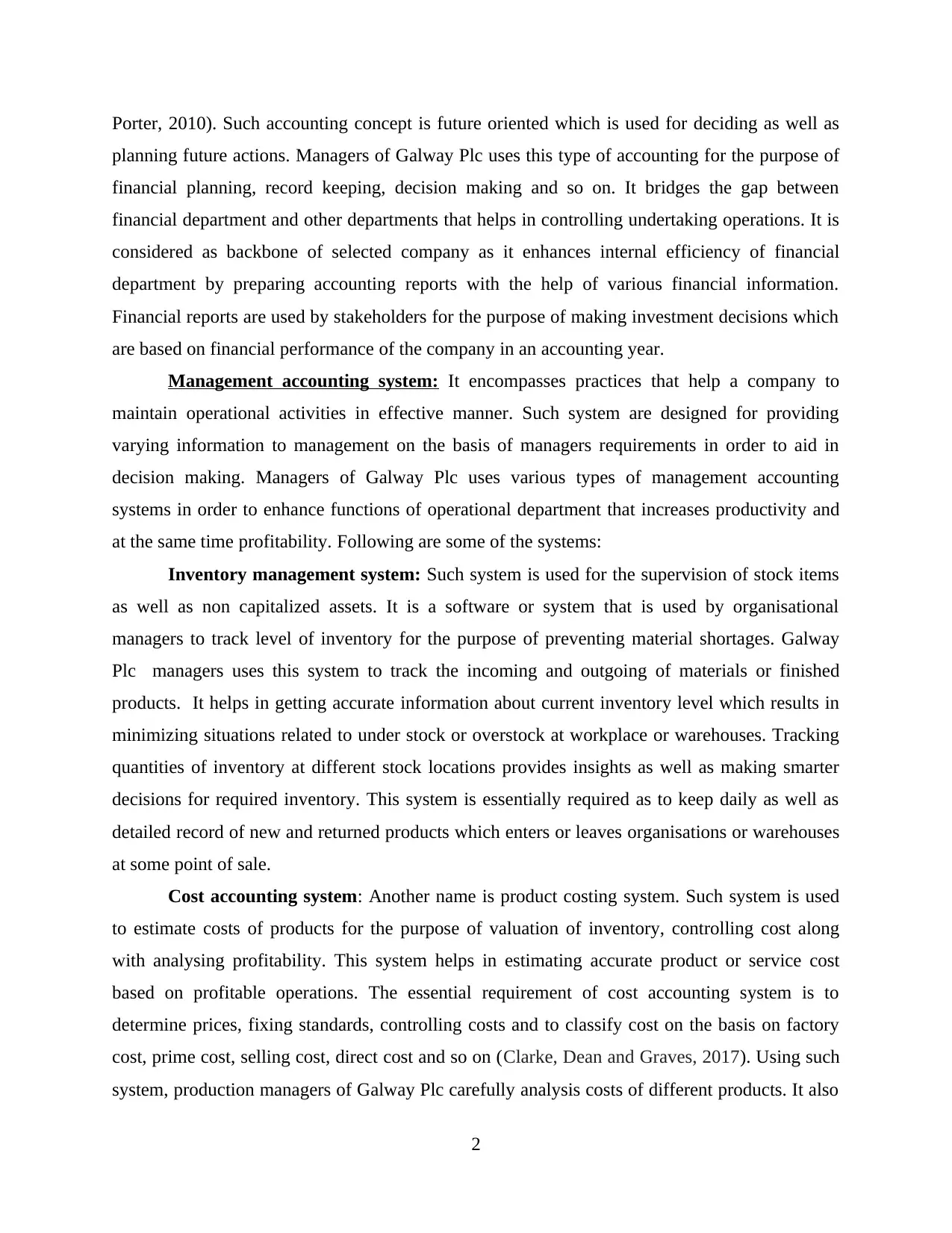
Porter, 2010). Such accounting concept is future oriented which is used for deciding as well as
planning future actions. Managers of Galway Plc uses this type of accounting for the purpose of
financial planning, record keeping, decision making and so on. It bridges the gap between
financial department and other departments that helps in controlling undertaking operations. It is
considered as backbone of selected company as it enhances internal efficiency of financial
department by preparing accounting reports with the help of various financial information.
Financial reports are used by stakeholders for the purpose of making investment decisions which
are based on financial performance of the company in an accounting year.
Management accounting system: It encompasses practices that help a company to
maintain operational activities in effective manner. Such system are designed for providing
varying information to management on the basis of managers requirements in order to aid in
decision making. Managers of Galway Plc uses various types of management accounting
systems in order to enhance functions of operational department that increases productivity and
at the same time profitability. Following are some of the systems:
Inventory management system: Such system is used for the supervision of stock items
as well as non capitalized assets. It is a software or system that is used by organisational
managers to track level of inventory for the purpose of preventing material shortages. Galway
Plc managers uses this system to track the incoming and outgoing of materials or finished
products. It helps in getting accurate information about current inventory level which results in
minimizing situations related to under stock or overstock at workplace or warehouses. Tracking
quantities of inventory at different stock locations provides insights as well as making smarter
decisions for required inventory. This system is essentially required as to keep daily as well as
detailed record of new and returned products which enters or leaves organisations or warehouses
at some point of sale.
Cost accounting system: Another name is product costing system. Such system is used
to estimate costs of products for the purpose of valuation of inventory, controlling cost along
with analysing profitability. This system helps in estimating accurate product or service cost
based on profitable operations. The essential requirement of cost accounting system is to
determine prices, fixing standards, controlling costs and to classify cost on the basis on factory
cost, prime cost, selling cost, direct cost and so on (Clarke, Dean and Graves, 2017). Using such
system, production managers of Galway Plc carefully analysis costs of different products. It also
2
planning future actions. Managers of Galway Plc uses this type of accounting for the purpose of
financial planning, record keeping, decision making and so on. It bridges the gap between
financial department and other departments that helps in controlling undertaking operations. It is
considered as backbone of selected company as it enhances internal efficiency of financial
department by preparing accounting reports with the help of various financial information.
Financial reports are used by stakeholders for the purpose of making investment decisions which
are based on financial performance of the company in an accounting year.
Management accounting system: It encompasses practices that help a company to
maintain operational activities in effective manner. Such system are designed for providing
varying information to management on the basis of managers requirements in order to aid in
decision making. Managers of Galway Plc uses various types of management accounting
systems in order to enhance functions of operational department that increases productivity and
at the same time profitability. Following are some of the systems:
Inventory management system: Such system is used for the supervision of stock items
as well as non capitalized assets. It is a software or system that is used by organisational
managers to track level of inventory for the purpose of preventing material shortages. Galway
Plc managers uses this system to track the incoming and outgoing of materials or finished
products. It helps in getting accurate information about current inventory level which results in
minimizing situations related to under stock or overstock at workplace or warehouses. Tracking
quantities of inventory at different stock locations provides insights as well as making smarter
decisions for required inventory. This system is essentially required as to keep daily as well as
detailed record of new and returned products which enters or leaves organisations or warehouses
at some point of sale.
Cost accounting system: Another name is product costing system. Such system is used
to estimate costs of products for the purpose of valuation of inventory, controlling cost along
with analysing profitability. This system helps in estimating accurate product or service cost
based on profitable operations. The essential requirement of cost accounting system is to
determine prices, fixing standards, controlling costs and to classify cost on the basis on factory
cost, prime cost, selling cost, direct cost and so on (Clarke, Dean and Graves, 2017). Using such
system, production managers of Galway Plc carefully analysis costs of different products. It also
2
Paraphrase This Document
Need a fresh take? Get an instant paraphrase of this document with our AI Paraphraser
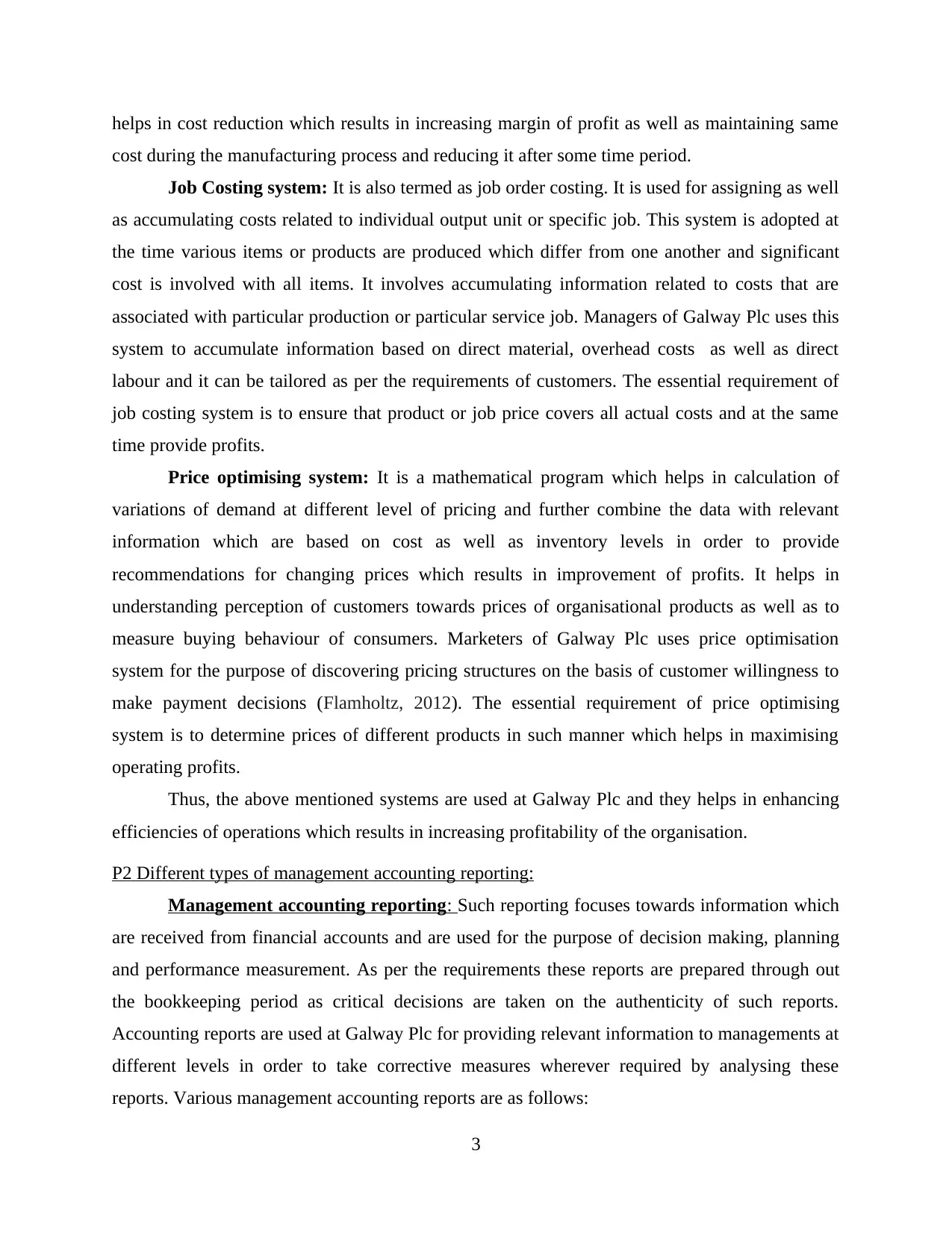
helps in cost reduction which results in increasing margin of profit as well as maintaining same
cost during the manufacturing process and reducing it after some time period.
Job Costing system: It is also termed as job order costing. It is used for assigning as well
as accumulating costs related to individual output unit or specific job. This system is adopted at
the time various items or products are produced which differ from one another and significant
cost is involved with all items. It involves accumulating information related to costs that are
associated with particular production or particular service job. Managers of Galway Plc uses this
system to accumulate information based on direct material, overhead costs as well as direct
labour and it can be tailored as per the requirements of customers. The essential requirement of
job costing system is to ensure that product or job price covers all actual costs and at the same
time provide profits.
Price optimising system: It is a mathematical program which helps in calculation of
variations of demand at different level of pricing and further combine the data with relevant
information which are based on cost as well as inventory levels in order to provide
recommendations for changing prices which results in improvement of profits. It helps in
understanding perception of customers towards prices of organisational products as well as to
measure buying behaviour of consumers. Marketers of Galway Plc uses price optimisation
system for the purpose of discovering pricing structures on the basis of customer willingness to
make payment decisions (Flamholtz, 2012). The essential requirement of price optimising
system is to determine prices of different products in such manner which helps in maximising
operating profits.
Thus, the above mentioned systems are used at Galway Plc and they helps in enhancing
efficiencies of operations which results in increasing profitability of the organisation.
P2 Different types of management accounting reporting:
Management accounting reporting: Such reporting focuses towards information which
are received from financial accounts and are used for the purpose of decision making, planning
and performance measurement. As per the requirements these reports are prepared through out
the bookkeeping period as critical decisions are taken on the authenticity of such reports.
Accounting reports are used at Galway Plc for providing relevant information to managements at
different levels in order to take corrective measures wherever required by analysing these
reports. Various management accounting reports are as follows:
3
cost during the manufacturing process and reducing it after some time period.
Job Costing system: It is also termed as job order costing. It is used for assigning as well
as accumulating costs related to individual output unit or specific job. This system is adopted at
the time various items or products are produced which differ from one another and significant
cost is involved with all items. It involves accumulating information related to costs that are
associated with particular production or particular service job. Managers of Galway Plc uses this
system to accumulate information based on direct material, overhead costs as well as direct
labour and it can be tailored as per the requirements of customers. The essential requirement of
job costing system is to ensure that product or job price covers all actual costs and at the same
time provide profits.
Price optimising system: It is a mathematical program which helps in calculation of
variations of demand at different level of pricing and further combine the data with relevant
information which are based on cost as well as inventory levels in order to provide
recommendations for changing prices which results in improvement of profits. It helps in
understanding perception of customers towards prices of organisational products as well as to
measure buying behaviour of consumers. Marketers of Galway Plc uses price optimisation
system for the purpose of discovering pricing structures on the basis of customer willingness to
make payment decisions (Flamholtz, 2012). The essential requirement of price optimising
system is to determine prices of different products in such manner which helps in maximising
operating profits.
Thus, the above mentioned systems are used at Galway Plc and they helps in enhancing
efficiencies of operations which results in increasing profitability of the organisation.
P2 Different types of management accounting reporting:
Management accounting reporting: Such reporting focuses towards information which
are received from financial accounts and are used for the purpose of decision making, planning
and performance measurement. As per the requirements these reports are prepared through out
the bookkeeping period as critical decisions are taken on the authenticity of such reports.
Accounting reports are used at Galway Plc for providing relevant information to managements at
different levels in order to take corrective measures wherever required by analysing these
reports. Various management accounting reports are as follows:
3
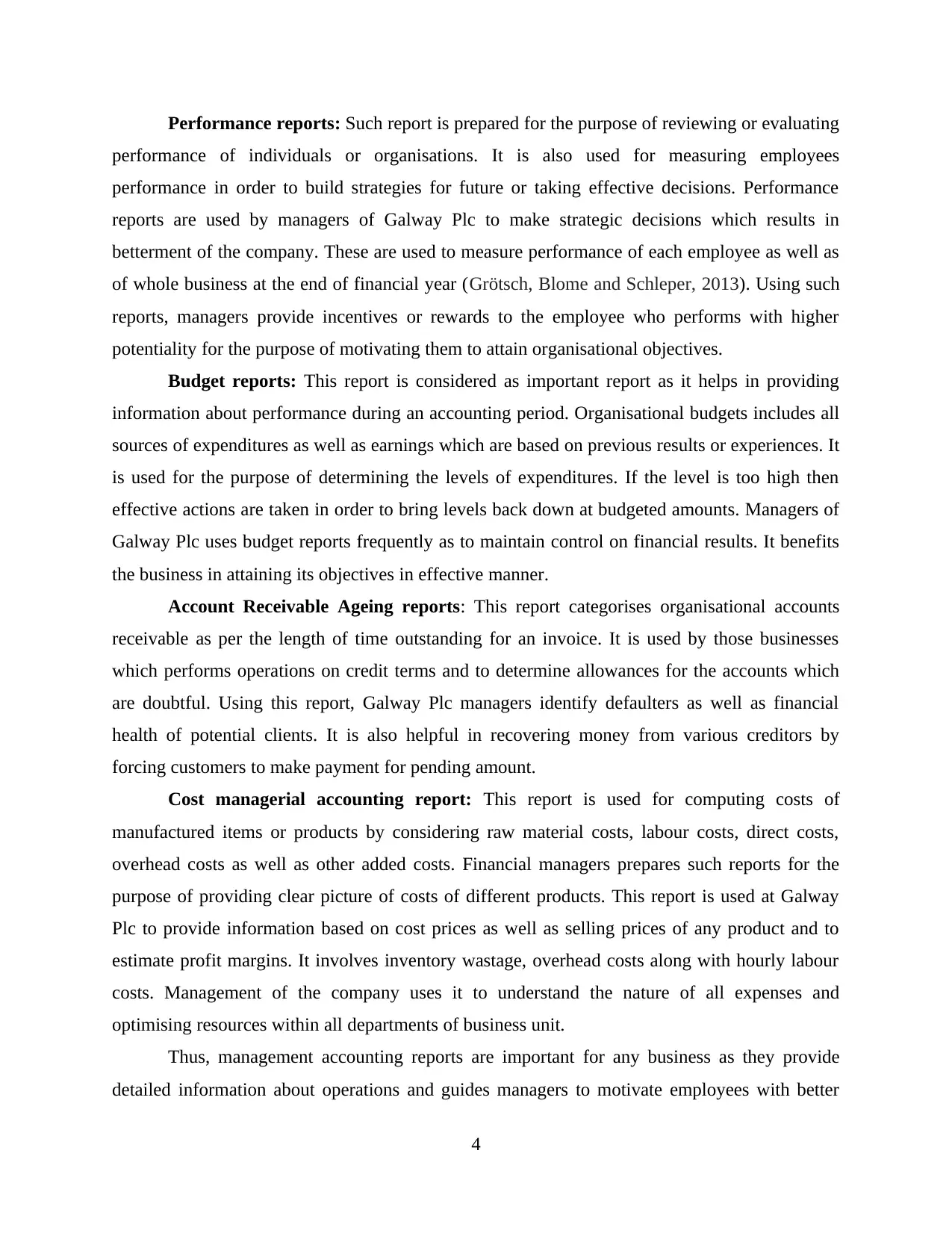
Performance reports: Such report is prepared for the purpose of reviewing or evaluating
performance of individuals or organisations. It is also used for measuring employees
performance in order to build strategies for future or taking effective decisions. Performance
reports are used by managers of Galway Plc to make strategic decisions which results in
betterment of the company. These are used to measure performance of each employee as well as
of whole business at the end of financial year (Grötsch, Blome and Schleper, 2013). Using such
reports, managers provide incentives or rewards to the employee who performs with higher
potentiality for the purpose of motivating them to attain organisational objectives.
Budget reports: This report is considered as important report as it helps in providing
information about performance during an accounting period. Organisational budgets includes all
sources of expenditures as well as earnings which are based on previous results or experiences. It
is used for the purpose of determining the levels of expenditures. If the level is too high then
effective actions are taken in order to bring levels back down at budgeted amounts. Managers of
Galway Plc uses budget reports frequently as to maintain control on financial results. It benefits
the business in attaining its objectives in effective manner.
Account Receivable Ageing reports: This report categorises organisational accounts
receivable as per the length of time outstanding for an invoice. It is used by those businesses
which performs operations on credit terms and to determine allowances for the accounts which
are doubtful. Using this report, Galway Plc managers identify defaulters as well as financial
health of potential clients. It is also helpful in recovering money from various creditors by
forcing customers to make payment for pending amount.
Cost managerial accounting report: This report is used for computing costs of
manufactured items or products by considering raw material costs, labour costs, direct costs,
overhead costs as well as other added costs. Financial managers prepares such reports for the
purpose of providing clear picture of costs of different products. This report is used at Galway
Plc to provide information based on cost prices as well as selling prices of any product and to
estimate profit margins. It involves inventory wastage, overhead costs along with hourly labour
costs. Management of the company uses it to understand the nature of all expenses and
optimising resources within all departments of business unit.
Thus, management accounting reports are important for any business as they provide
detailed information about operations and guides managers to motivate employees with better
4
performance of individuals or organisations. It is also used for measuring employees
performance in order to build strategies for future or taking effective decisions. Performance
reports are used by managers of Galway Plc to make strategic decisions which results in
betterment of the company. These are used to measure performance of each employee as well as
of whole business at the end of financial year (Grötsch, Blome and Schleper, 2013). Using such
reports, managers provide incentives or rewards to the employee who performs with higher
potentiality for the purpose of motivating them to attain organisational objectives.
Budget reports: This report is considered as important report as it helps in providing
information about performance during an accounting period. Organisational budgets includes all
sources of expenditures as well as earnings which are based on previous results or experiences. It
is used for the purpose of determining the levels of expenditures. If the level is too high then
effective actions are taken in order to bring levels back down at budgeted amounts. Managers of
Galway Plc uses budget reports frequently as to maintain control on financial results. It benefits
the business in attaining its objectives in effective manner.
Account Receivable Ageing reports: This report categorises organisational accounts
receivable as per the length of time outstanding for an invoice. It is used by those businesses
which performs operations on credit terms and to determine allowances for the accounts which
are doubtful. Using this report, Galway Plc managers identify defaulters as well as financial
health of potential clients. It is also helpful in recovering money from various creditors by
forcing customers to make payment for pending amount.
Cost managerial accounting report: This report is used for computing costs of
manufactured items or products by considering raw material costs, labour costs, direct costs,
overhead costs as well as other added costs. Financial managers prepares such reports for the
purpose of providing clear picture of costs of different products. This report is used at Galway
Plc to provide information based on cost prices as well as selling prices of any product and to
estimate profit margins. It involves inventory wastage, overhead costs along with hourly labour
costs. Management of the company uses it to understand the nature of all expenses and
optimising resources within all departments of business unit.
Thus, management accounting reports are important for any business as they provide
detailed information about operations and guides managers to motivate employees with better
4
⊘ This is a preview!⊘
Do you want full access?
Subscribe today to unlock all pages.

Trusted by 1+ million students worldwide
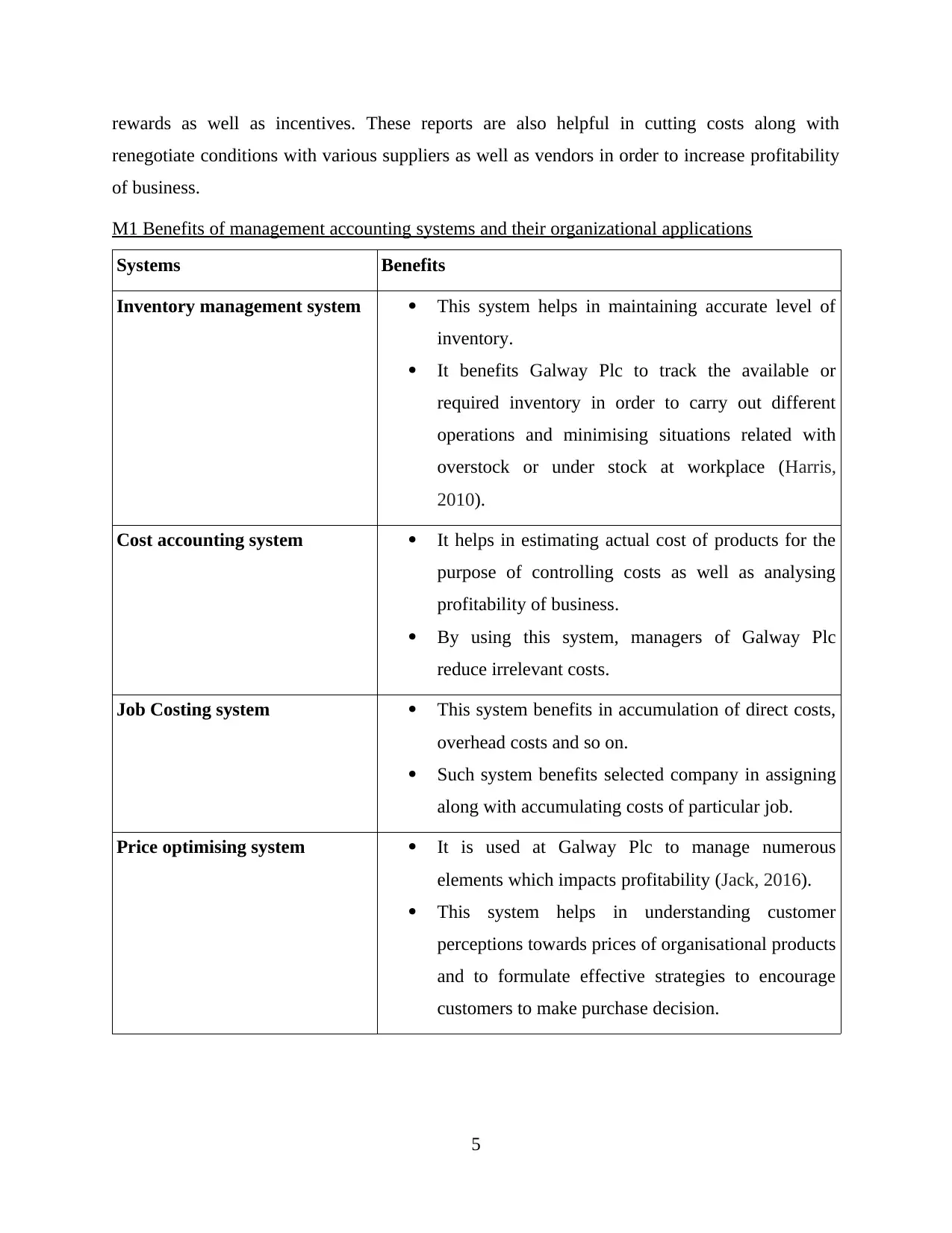
rewards as well as incentives. These reports are also helpful in cutting costs along with
renegotiate conditions with various suppliers as well as vendors in order to increase profitability
of business.
M1 Benefits of management accounting systems and their organizational applications
Systems Benefits
Inventory management system This system helps in maintaining accurate level of
inventory.
It benefits Galway Plc to track the available or
required inventory in order to carry out different
operations and minimising situations related with
overstock or under stock at workplace (Harris,
2010).
Cost accounting system It helps in estimating actual cost of products for the
purpose of controlling costs as well as analysing
profitability of business.
By using this system, managers of Galway Plc
reduce irrelevant costs.
Job Costing system This system benefits in accumulation of direct costs,
overhead costs and so on.
Such system benefits selected company in assigning
along with accumulating costs of particular job.
Price optimising system It is used at Galway Plc to manage numerous
elements which impacts profitability (Jack, 2016).
This system helps in understanding customer
perceptions towards prices of organisational products
and to formulate effective strategies to encourage
customers to make purchase decision.
5
renegotiate conditions with various suppliers as well as vendors in order to increase profitability
of business.
M1 Benefits of management accounting systems and their organizational applications
Systems Benefits
Inventory management system This system helps in maintaining accurate level of
inventory.
It benefits Galway Plc to track the available or
required inventory in order to carry out different
operations and minimising situations related with
overstock or under stock at workplace (Harris,
2010).
Cost accounting system It helps in estimating actual cost of products for the
purpose of controlling costs as well as analysing
profitability of business.
By using this system, managers of Galway Plc
reduce irrelevant costs.
Job Costing system This system benefits in accumulation of direct costs,
overhead costs and so on.
Such system benefits selected company in assigning
along with accumulating costs of particular job.
Price optimising system It is used at Galway Plc to manage numerous
elements which impacts profitability (Jack, 2016).
This system helps in understanding customer
perceptions towards prices of organisational products
and to formulate effective strategies to encourage
customers to make purchase decision.
5
Paraphrase This Document
Need a fresh take? Get an instant paraphrase of this document with our AI Paraphraser
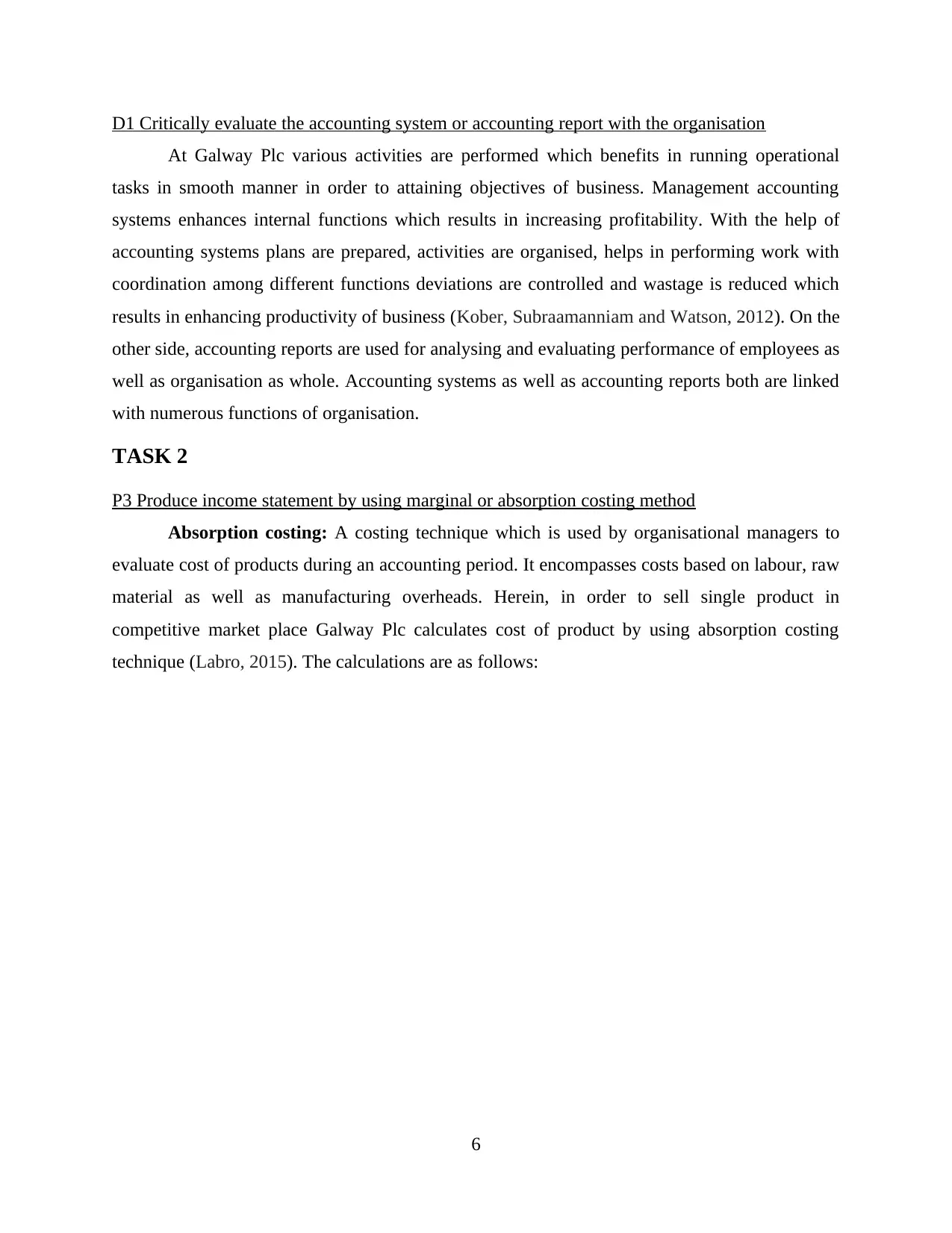
D1 Critically evaluate the accounting system or accounting report with the organisation
At Galway Plc various activities are performed which benefits in running operational
tasks in smooth manner in order to attaining objectives of business. Management accounting
systems enhances internal functions which results in increasing profitability. With the help of
accounting systems plans are prepared, activities are organised, helps in performing work with
coordination among different functions deviations are controlled and wastage is reduced which
results in enhancing productivity of business (Kober, Subraamanniam and Watson, 2012). On the
other side, accounting reports are used for analysing and evaluating performance of employees as
well as organisation as whole. Accounting systems as well as accounting reports both are linked
with numerous functions of organisation.
TASK 2
P3 Produce income statement by using marginal or absorption costing method
Absorption costing: A costing technique which is used by organisational managers to
evaluate cost of products during an accounting period. It encompasses costs based on labour, raw
material as well as manufacturing overheads. Herein, in order to sell single product in
competitive market place Galway Plc calculates cost of product by using absorption costing
technique (Labro, 2015). The calculations are as follows:
6
At Galway Plc various activities are performed which benefits in running operational
tasks in smooth manner in order to attaining objectives of business. Management accounting
systems enhances internal functions which results in increasing profitability. With the help of
accounting systems plans are prepared, activities are organised, helps in performing work with
coordination among different functions deviations are controlled and wastage is reduced which
results in enhancing productivity of business (Kober, Subraamanniam and Watson, 2012). On the
other side, accounting reports are used for analysing and evaluating performance of employees as
well as organisation as whole. Accounting systems as well as accounting reports both are linked
with numerous functions of organisation.
TASK 2
P3 Produce income statement by using marginal or absorption costing method
Absorption costing: A costing technique which is used by organisational managers to
evaluate cost of products during an accounting period. It encompasses costs based on labour, raw
material as well as manufacturing overheads. Herein, in order to sell single product in
competitive market place Galway Plc calculates cost of product by using absorption costing
technique (Labro, 2015). The calculations are as follows:
6
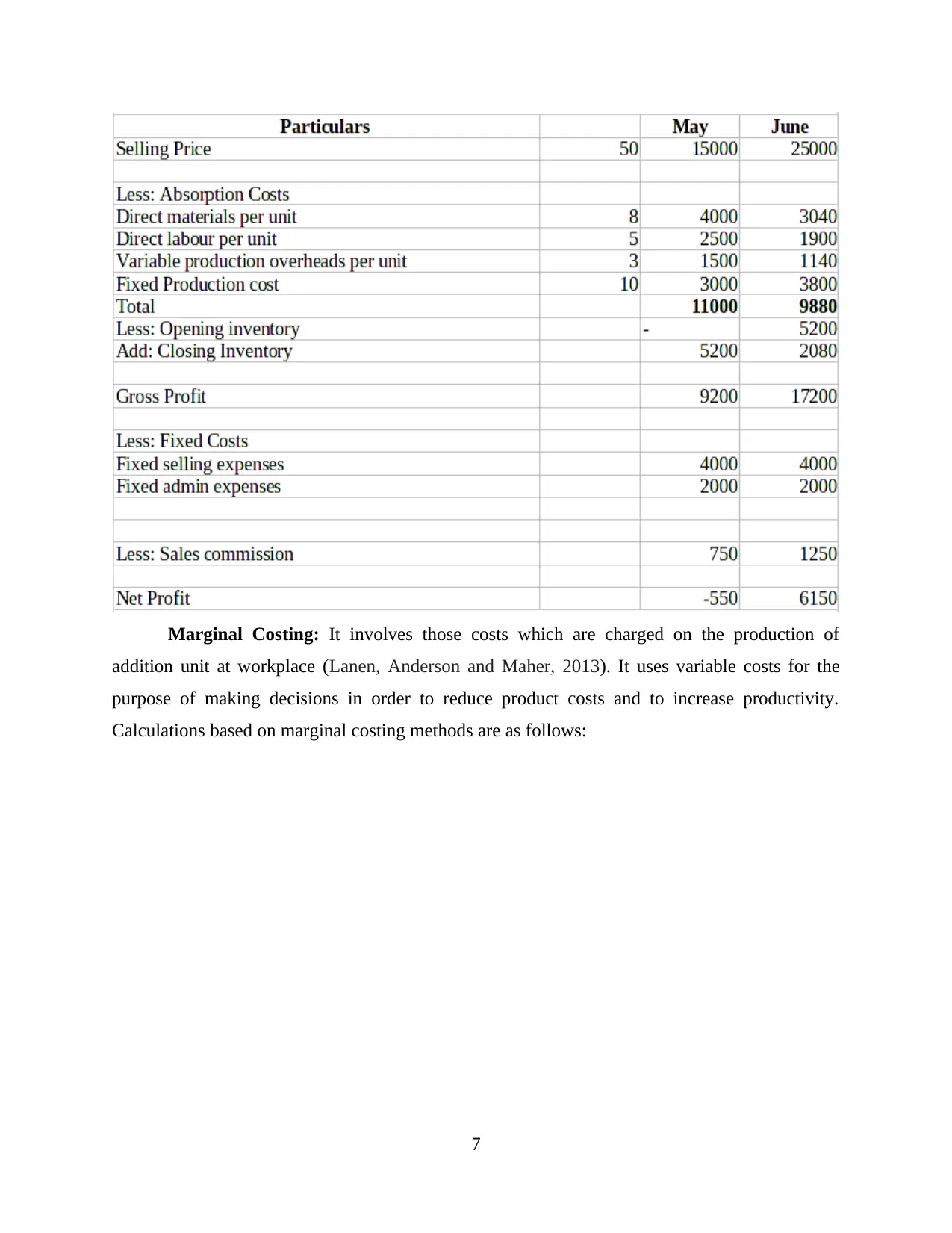
Marginal Costing: It involves those costs which are charged on the production of
addition unit at workplace (Lanen, Anderson and Maher, 2013). It uses variable costs for the
purpose of making decisions in order to reduce product costs and to increase productivity.
Calculations based on marginal costing methods are as follows:
7
addition unit at workplace (Lanen, Anderson and Maher, 2013). It uses variable costs for the
purpose of making decisions in order to reduce product costs and to increase productivity.
Calculations based on marginal costing methods are as follows:
7
⊘ This is a preview!⊘
Do you want full access?
Subscribe today to unlock all pages.

Trusted by 1+ million students worldwide
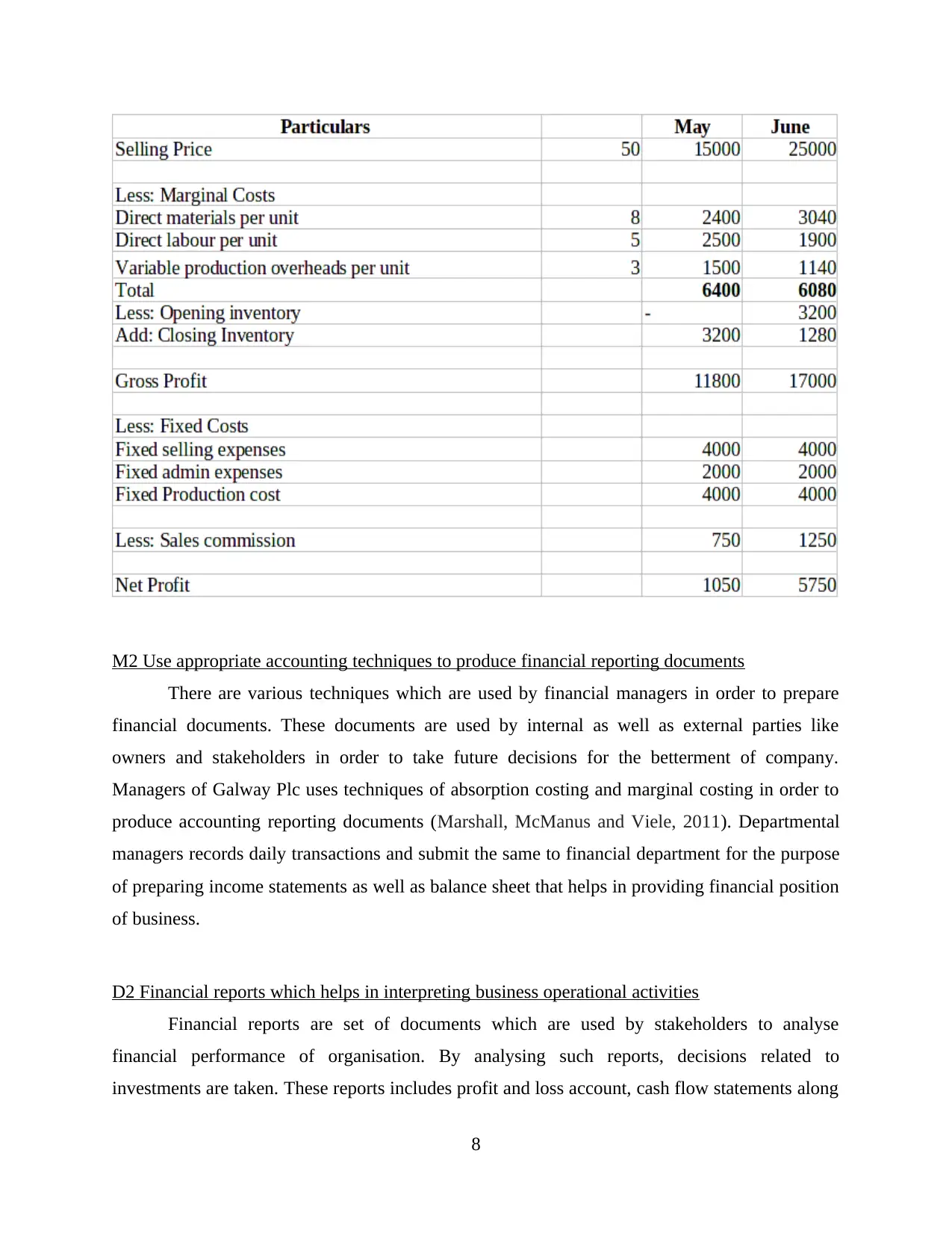
M2 Use appropriate accounting techniques to produce financial reporting documents
There are various techniques which are used by financial managers in order to prepare
financial documents. These documents are used by internal as well as external parties like
owners and stakeholders in order to take future decisions for the betterment of company.
Managers of Galway Plc uses techniques of absorption costing and marginal costing in order to
produce accounting reporting documents (Marshall, McManus and Viele, 2011). Departmental
managers records daily transactions and submit the same to financial department for the purpose
of preparing income statements as well as balance sheet that helps in providing financial position
of business.
D2 Financial reports which helps in interpreting business operational activities
Financial reports are set of documents which are used by stakeholders to analyse
financial performance of organisation. By analysing such reports, decisions related to
investments are taken. These reports includes profit and loss account, cash flow statements along
8
There are various techniques which are used by financial managers in order to prepare
financial documents. These documents are used by internal as well as external parties like
owners and stakeholders in order to take future decisions for the betterment of company.
Managers of Galway Plc uses techniques of absorption costing and marginal costing in order to
produce accounting reporting documents (Marshall, McManus and Viele, 2011). Departmental
managers records daily transactions and submit the same to financial department for the purpose
of preparing income statements as well as balance sheet that helps in providing financial position
of business.
D2 Financial reports which helps in interpreting business operational activities
Financial reports are set of documents which are used by stakeholders to analyse
financial performance of organisation. By analysing such reports, decisions related to
investments are taken. These reports includes profit and loss account, cash flow statements along
8
Paraphrase This Document
Need a fresh take? Get an instant paraphrase of this document with our AI Paraphraser
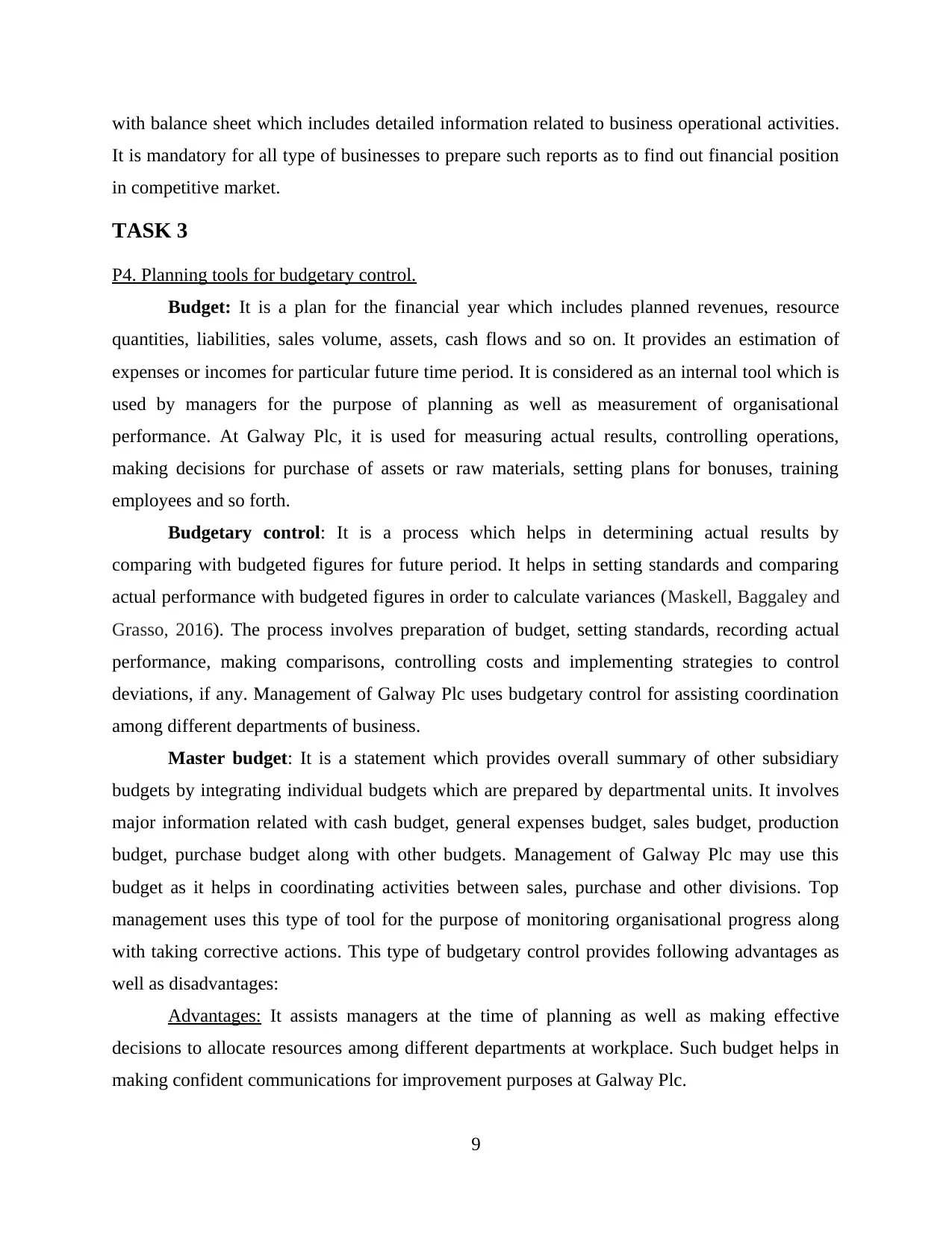
with balance sheet which includes detailed information related to business operational activities.
It is mandatory for all type of businesses to prepare such reports as to find out financial position
in competitive market.
TASK 3
P4. Planning tools for budgetary control.
Budget: It is a plan for the financial year which includes planned revenues, resource
quantities, liabilities, sales volume, assets, cash flows and so on. It provides an estimation of
expenses or incomes for particular future time period. It is considered as an internal tool which is
used by managers for the purpose of planning as well as measurement of organisational
performance. At Galway Plc, it is used for measuring actual results, controlling operations,
making decisions for purchase of assets or raw materials, setting plans for bonuses, training
employees and so forth.
Budgetary control: It is a process which helps in determining actual results by
comparing with budgeted figures for future period. It helps in setting standards and comparing
actual performance with budgeted figures in order to calculate variances (Maskell, Baggaley and
Grasso, 2016). The process involves preparation of budget, setting standards, recording actual
performance, making comparisons, controlling costs and implementing strategies to control
deviations, if any. Management of Galway Plc uses budgetary control for assisting coordination
among different departments of business.
Master budget: It is a statement which provides overall summary of other subsidiary
budgets by integrating individual budgets which are prepared by departmental units. It involves
major information related with cash budget, general expenses budget, sales budget, production
budget, purchase budget along with other budgets. Management of Galway Plc may use this
budget as it helps in coordinating activities between sales, purchase and other divisions. Top
management uses this type of tool for the purpose of monitoring organisational progress along
with taking corrective actions. This type of budgetary control provides following advantages as
well as disadvantages:
Advantages: It assists managers at the time of planning as well as making effective
decisions to allocate resources among different departments at workplace. Such budget helps in
making confident communications for improvement purposes at Galway Plc.
9
It is mandatory for all type of businesses to prepare such reports as to find out financial position
in competitive market.
TASK 3
P4. Planning tools for budgetary control.
Budget: It is a plan for the financial year which includes planned revenues, resource
quantities, liabilities, sales volume, assets, cash flows and so on. It provides an estimation of
expenses or incomes for particular future time period. It is considered as an internal tool which is
used by managers for the purpose of planning as well as measurement of organisational
performance. At Galway Plc, it is used for measuring actual results, controlling operations,
making decisions for purchase of assets or raw materials, setting plans for bonuses, training
employees and so forth.
Budgetary control: It is a process which helps in determining actual results by
comparing with budgeted figures for future period. It helps in setting standards and comparing
actual performance with budgeted figures in order to calculate variances (Maskell, Baggaley and
Grasso, 2016). The process involves preparation of budget, setting standards, recording actual
performance, making comparisons, controlling costs and implementing strategies to control
deviations, if any. Management of Galway Plc uses budgetary control for assisting coordination
among different departments of business.
Master budget: It is a statement which provides overall summary of other subsidiary
budgets by integrating individual budgets which are prepared by departmental units. It involves
major information related with cash budget, general expenses budget, sales budget, production
budget, purchase budget along with other budgets. Management of Galway Plc may use this
budget as it helps in coordinating activities between sales, purchase and other divisions. Top
management uses this type of tool for the purpose of monitoring organisational progress along
with taking corrective actions. This type of budgetary control provides following advantages as
well as disadvantages:
Advantages: It assists managers at the time of planning as well as making effective
decisions to allocate resources among different departments at workplace. Such budget helps in
making confident communications for improvement purposes at Galway Plc.
9
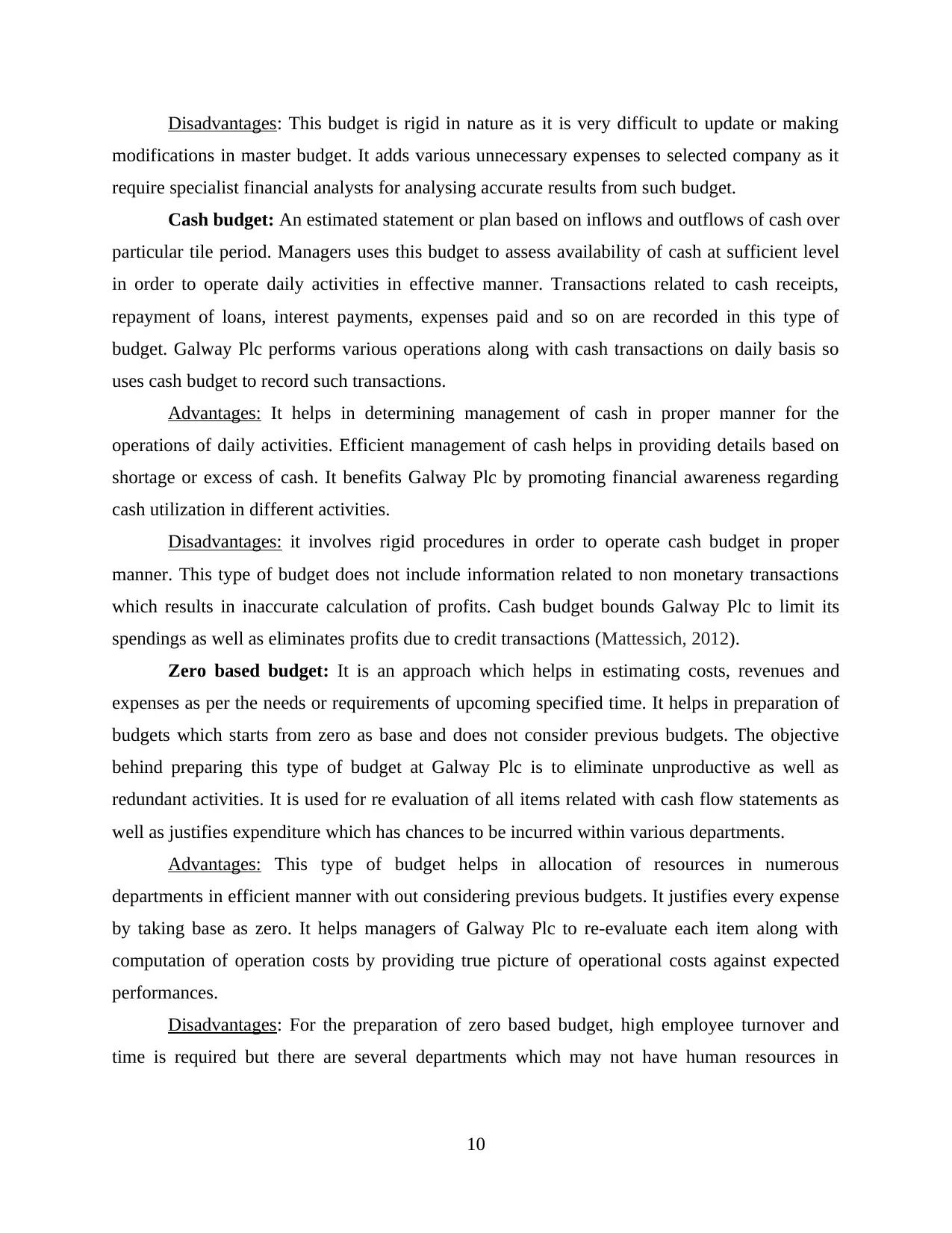
Disadvantages: This budget is rigid in nature as it is very difficult to update or making
modifications in master budget. It adds various unnecessary expenses to selected company as it
require specialist financial analysts for analysing accurate results from such budget.
Cash budget: An estimated statement or plan based on inflows and outflows of cash over
particular tile period. Managers uses this budget to assess availability of cash at sufficient level
in order to operate daily activities in effective manner. Transactions related to cash receipts,
repayment of loans, interest payments, expenses paid and so on are recorded in this type of
budget. Galway Plc performs various operations along with cash transactions on daily basis so
uses cash budget to record such transactions.
Advantages: It helps in determining management of cash in proper manner for the
operations of daily activities. Efficient management of cash helps in providing details based on
shortage or excess of cash. It benefits Galway Plc by promoting financial awareness regarding
cash utilization in different activities.
Disadvantages: it involves rigid procedures in order to operate cash budget in proper
manner. This type of budget does not include information related to non monetary transactions
which results in inaccurate calculation of profits. Cash budget bounds Galway Plc to limit its
spendings as well as eliminates profits due to credit transactions (Mattessich, 2012).
Zero based budget: It is an approach which helps in estimating costs, revenues and
expenses as per the needs or requirements of upcoming specified time. It helps in preparation of
budgets which starts from zero as base and does not consider previous budgets. The objective
behind preparing this type of budget at Galway Plc is to eliminate unproductive as well as
redundant activities. It is used for re evaluation of all items related with cash flow statements as
well as justifies expenditure which has chances to be incurred within various departments.
Advantages: This type of budget helps in allocation of resources in numerous
departments in efficient manner with out considering previous budgets. It justifies every expense
by taking base as zero. It helps managers of Galway Plc to re-evaluate each item along with
computation of operation costs by providing true picture of operational costs against expected
performances.
Disadvantages: For the preparation of zero based budget, high employee turnover and
time is required but there are several departments which may not have human resources in
10
modifications in master budget. It adds various unnecessary expenses to selected company as it
require specialist financial analysts for analysing accurate results from such budget.
Cash budget: An estimated statement or plan based on inflows and outflows of cash over
particular tile period. Managers uses this budget to assess availability of cash at sufficient level
in order to operate daily activities in effective manner. Transactions related to cash receipts,
repayment of loans, interest payments, expenses paid and so on are recorded in this type of
budget. Galway Plc performs various operations along with cash transactions on daily basis so
uses cash budget to record such transactions.
Advantages: It helps in determining management of cash in proper manner for the
operations of daily activities. Efficient management of cash helps in providing details based on
shortage or excess of cash. It benefits Galway Plc by promoting financial awareness regarding
cash utilization in different activities.
Disadvantages: it involves rigid procedures in order to operate cash budget in proper
manner. This type of budget does not include information related to non monetary transactions
which results in inaccurate calculation of profits. Cash budget bounds Galway Plc to limit its
spendings as well as eliminates profits due to credit transactions (Mattessich, 2012).
Zero based budget: It is an approach which helps in estimating costs, revenues and
expenses as per the needs or requirements of upcoming specified time. It helps in preparation of
budgets which starts from zero as base and does not consider previous budgets. The objective
behind preparing this type of budget at Galway Plc is to eliminate unproductive as well as
redundant activities. It is used for re evaluation of all items related with cash flow statements as
well as justifies expenditure which has chances to be incurred within various departments.
Advantages: This type of budget helps in allocation of resources in numerous
departments in efficient manner with out considering previous budgets. It justifies every expense
by taking base as zero. It helps managers of Galway Plc to re-evaluate each item along with
computation of operation costs by providing true picture of operational costs against expected
performances.
Disadvantages: For the preparation of zero based budget, high employee turnover and
time is required but there are several departments which may not have human resources in
10
⊘ This is a preview!⊘
Do you want full access?
Subscribe today to unlock all pages.

Trusted by 1+ million students worldwide
1 out of 18
Related Documents
Your All-in-One AI-Powered Toolkit for Academic Success.
+13062052269
info@desklib.com
Available 24*7 on WhatsApp / Email
![[object Object]](/_next/static/media/star-bottom.7253800d.svg)
Unlock your academic potential
Copyright © 2020–2025 A2Z Services. All Rights Reserved. Developed and managed by ZUCOL.





